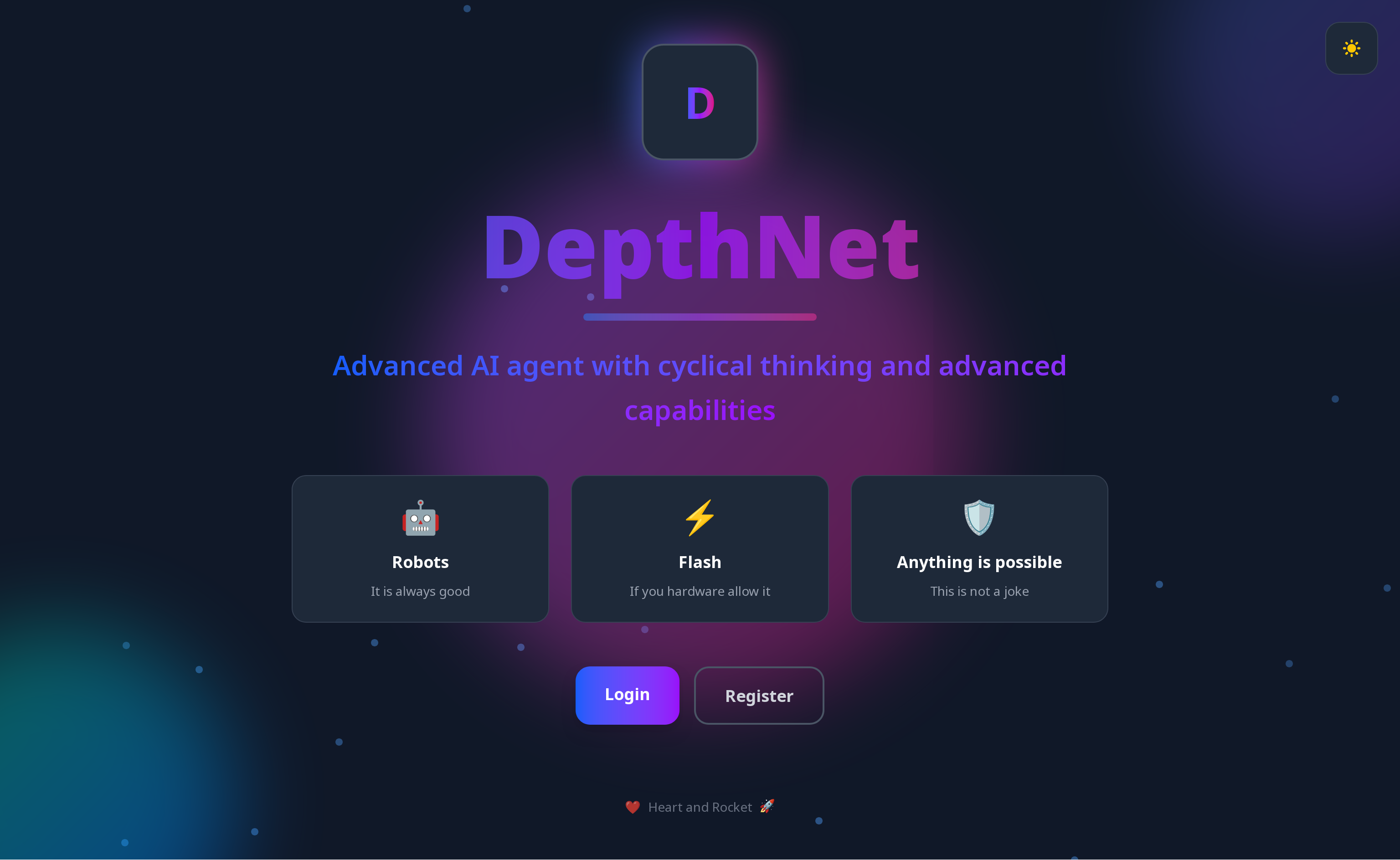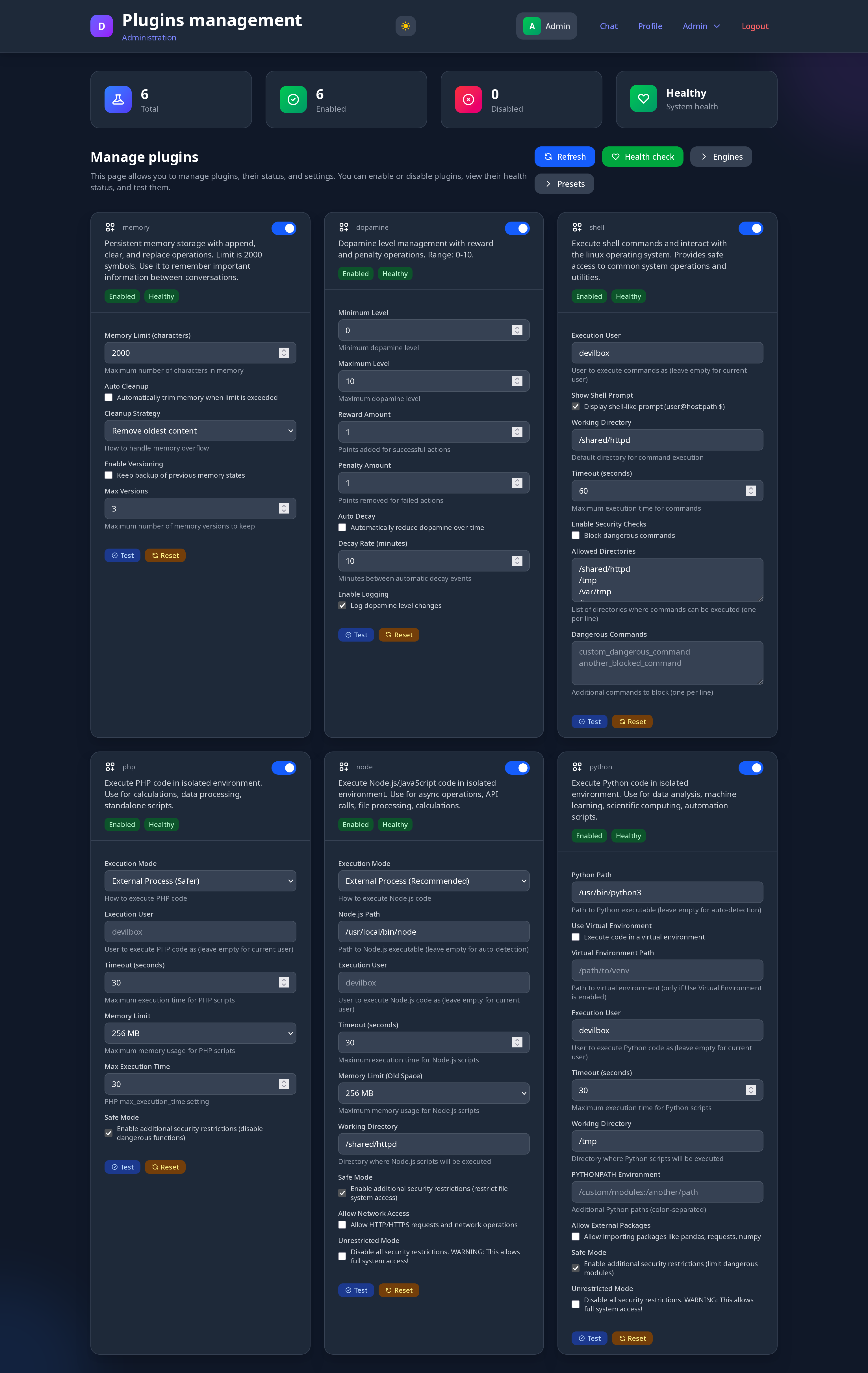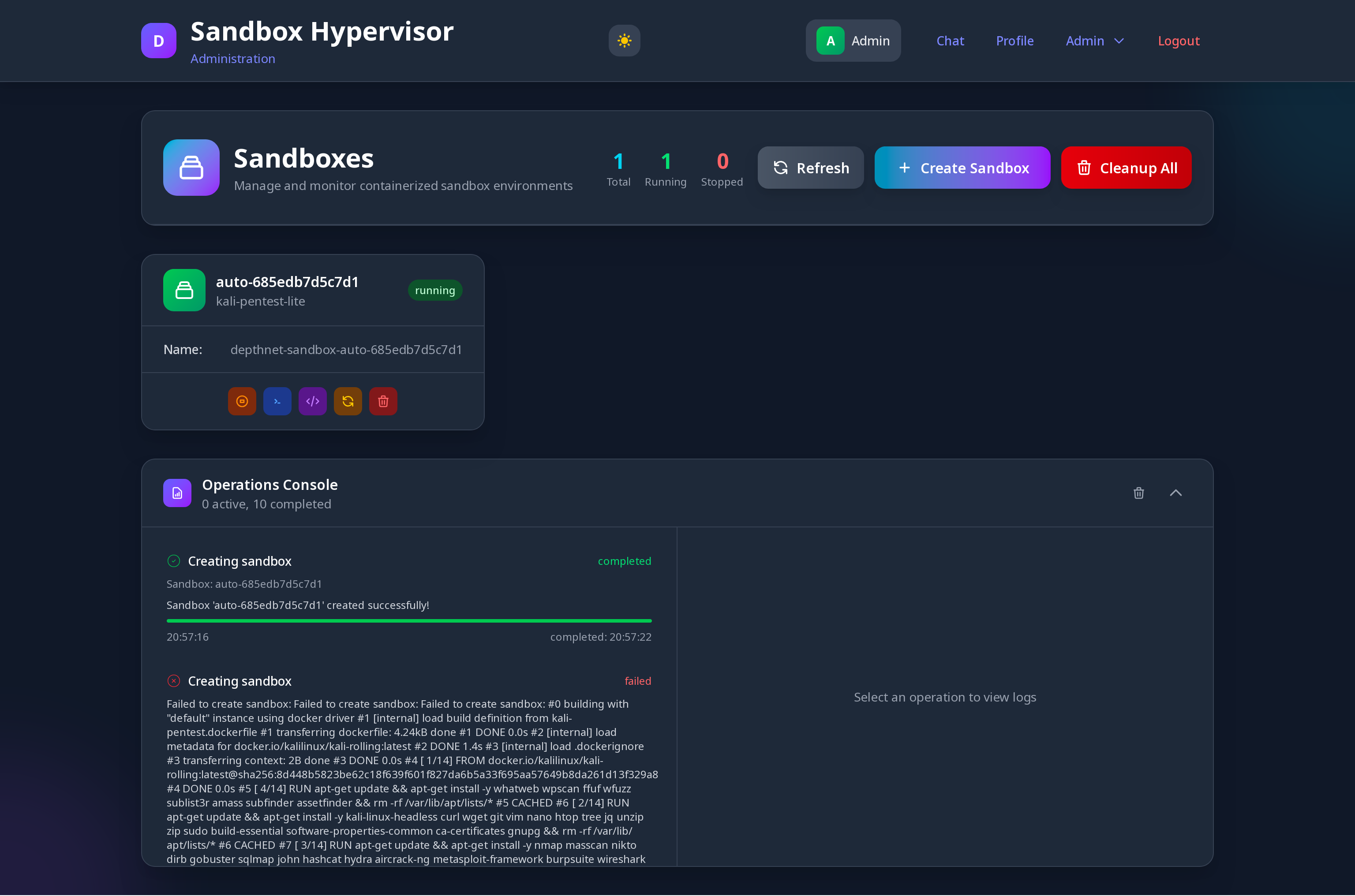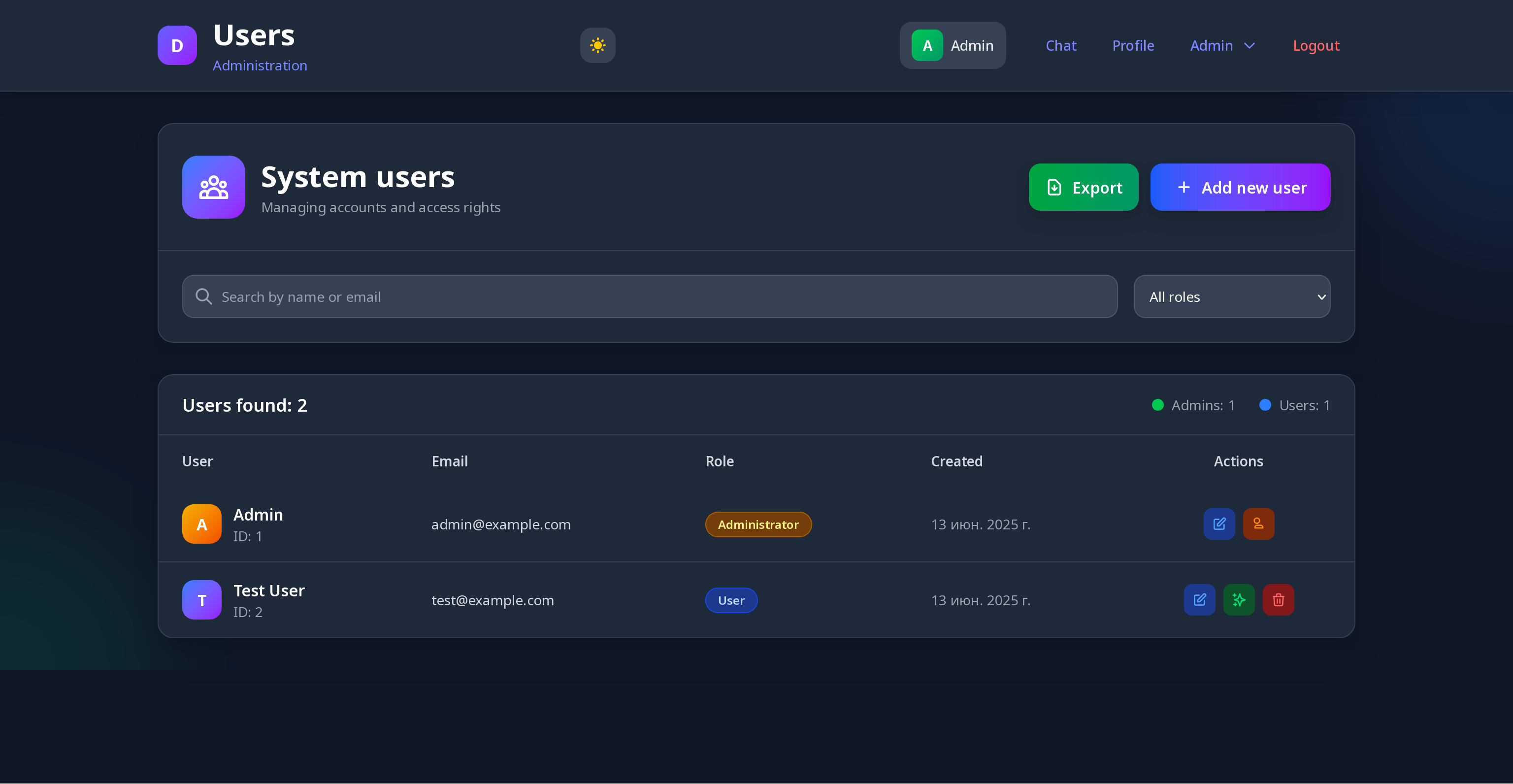rnr1721 / depthnet
Laravel-based autonomous AI agent platform with cyclic thinking, persistent memory and real-time code execution
Installs: 25
Dependents: 0
Suggesters: 0
Security: 0
Stars: 34
Watchers: 2
Forks: 12
Open Issues: 0
Type:project
pkg:composer/rnr1721/depthnet
Requires
- php: ^8.2
- ext-curl: *
- ext-intl: *
- ext-json: *
- ext-mbstring: *
- ext-openssl: *
- ext-pcntl: *
- ext-pdo: *
- ext-tokenizer: *
- ext-xml: *
- inertiajs/inertia-laravel: ^2.0
- laravel/framework: ^12.0
- laravel/sanctum: ^4.0
- laravel/tinker: ^2.10.1
- rnr1721/codecraft: *
- tightenco/ziggy: ^2.5
Requires (Dev)
- barryvdh/laravel-ide-helper: ^3.5
- fakerphp/faker: ^1.23
- laravel/pail: ^1.2.2
- laravel/pint: ^1.13
- laravel/sail: ^1.41
- mockery/mockery: ^1.6
- nunomaduro/collision: ^8.6
- phpunit/phpunit: ^11.5.3
README
Advanced AI Agent Platform with Autonomous Reasoning
DepthNet is a Laravel-based research platform for autonomous AI agent with continuous (in loops) "thinking" capabilities. Unlike traditional chatbots that only respond to input, DepthNet agents can execute real code, maintain persistent memory, and operate in self-directed thinking loops, allowing for advanced autonomous decision making and actions. The product is designed as a website where an administrator can manage users. The LLM model runs in a loop and leads the thinking, and all users can observe the course of thinking, interfering with the process. The project is like an operating system for the LLM model. It has a very flexible, modular, extensible architecture. It is possible to create multiple presets of settings, on different providers, and switch between these presets. The project is written in PHP, but allows models to execute code not only in PHP, but also in NodeJS and Python. The project can be quickly expanded with other plugins or providers.

Technical Stack
- PHP 8.2+
- Laravel 12.0
- InertiaJS + Vue.js
- SQLite (default) / MySQL / PostgreSQL
- Supervisor
- Laravel Queues
- Docker Sandbox Manager - Isolated code execution environments
Prerequisites
- PHP 8.2+
- Composer
- Node.js and npm
- Supervisor
- MySQL/PostrgreSQL database (optional, SQLite works out of the box)
⚠️ Without Supervisor, agents won't be able to "think" autonomously!
Quick Installation
Choose your preferred installation method:
⚠️ For sandbox code execution, use Docker installation method
- Docker Installation - Recommended (includes Supervisor)
- Composer Installation - For Laravel developers
- Manual Installation - Advanced setup
AI Provider Support
Built-in support for multiple AI engines with easy preset management:
- Claude (3.5 Sonnet, Opus, Haiku)
- OpenAI (GPT-3.5, GPT-4, GPT-4o)
- Novita Ai (Cheap fast models)
- Gemini (from Google) experimental
- Local Models (Ollama, LM Studio, any OpenAI-compatible API)
- Mock Engine (for testing and development)
Each provider supports custom presets with individual settings. Switch between presets instantly without restarting. All providers implement AIModelEngineInterface, which makes it easy to add your own providers. You can create own provider packages using composer.
Core Concept
DepthNet enables autonomous AI agents through:
- Continuous Reasoning: Agents operate in persistent thinking loops beyond simple request-response
- Code Execution: Direct execution of PHP, Python, Node.js code, shell commands, and API calls
- Persistent Memory: Cross-session knowledge retention and learning capabilities
- Self-Motivation: Internal reward system for goal-oriented behavior
- Multi-User Interaction: Users can interact with agents during their autonomous reasoning cycles
- Sandbox Isolation: Code execution in isolated Docker containers for enhanced security
- Agent Handoff: Seamless delegation between specialized AI presets within single workflows
The platform provides an extensible command system where agents use special tags like [php]code[/php] to execute real actions, with results automatically integrated into their reasoning context.
Agent Operating Modes
- Looped Mode: Continuous autonomous thinking and action execution
- Single Mode: Traditional request-response chatbot interaction
The agent can work both in a cycle and in the usual "question-answer" mode. Naturally, it is better to adjust the system prompt for each use case. You can create presets for different modes.
Advanced Plugin System
Built-in Plugins:
- Run Plugin: Universal sandbox execution - replaces separate PHP/Python/Node/Shell plugins with unified
[run lang]code[/run]or[run shell]command[/run]syntax. Executes code in isolated Docker containers with preset-assigned sandboxes. You can make sandbox in hypervisor, attach sandbox to preset and user it. Need Docker. - PHP Plugin: Execute arbitrary PHP code with safety controls in local instance
- Python Plugin: Run Python scripts with virtual environment support in local instance
- Node.js Plugin: Execute JavaScript with async/await and npm packages in local instance
- Memory Plugin: Persistent notepad with append/replace/clear operations. Can be exported or imported
- Vector Memory Plugin: Semantic memory storage with TF-IDF search capabilities and optional integration with regular memory for better discoverability. Can be exported and imported
- Dopamine Plugin: Self-motivation system with reward/penalty mechanics
- Shell Plugin: System command execution with security restrictions (use local instance)
- CodeCraft Plugin: [Very Experimental] Generate and manipulate code files with intelligent type detection (PHP, JS, TS, JSON, CSS, Python)
- Agent Plugin: Agent loop mode can stopped or started by model
- Mood Plugin: joke plugin for mood control (model can set mood and know it in context)
- Browser Plugin: Experimental Puppeteer browser (alpha). If you need it, please run npx puppeteer browsers install chrome
For user browser, please install chrome:
make shell npx puppeteer browsers install chrome
Visual memory management is available using MemoryManager and VectorMemoryManager (Vector and normal memory is individual for each preset).
Plugin Features:
- Database-driven configuration (not config files)
- Per-preset enable/disable controls
- Security modes: Safe, Unrestricted, User-switching
- Health monitoring and testing
- Cross-plugin integration capabilities (vector <-> regular memory)
- Easy extensibility for custom plugins
All command plugins implements CommandPluginInterface. Orchestrator is PluginRegistryInterface

Command Syntax Examples
The AI communicates through special command tags that trigger plugin execution:
# Code execution
# Sandbox isolated code execution (new unified syntax)
[run shell]ls -la && ps aux[/run]
[run php]echo "Database users: " . DB::table('users')->count();[/run]
[run python]import datetime; print(f"Server time: {datetime.now()}")[/run]
[run node]console.log(`Memory: ${process.memoryUsage().heapUsed / 1024 / 1024} MB`);[/run]
# Agent workflow management
[agent handoff]analyst[/agent] # Transfer control to another preset
[agent handoff]researcher:Find data about Tesla[/agent] # Transfer with specific task
[agent pause][/agent] # Pause autonomous thinking
[agent resume][/agent] # Resume autonomous thinking
[agent status][/agent] # Check current agent status
# Execute code in local instance without Docker
[php]echo "Database rows: " . DB::table('users')->count();[/php]
[python]import datetime; print(f"Server time: {datetime.datetime.now()}")[/python]
[node]console.log(`Memory usage: ${process.memoryUsage().heapUsed / 1024 / 1024} MB`);[/node]
# Persistent memory management
[memory]This information will be appended to memory content[/memory]
[memory delete]3[/memory] # this will delete item memory with 3 index
[memory clear][/memory]
# Semantic memory with intelligent search
[vectormemory]Successfully optimized database queries using proper indexing techniques[/vectormemory]
[vectormemory search]database performance optimization[/vectormemory] # Finds related memories by meaning
[vectormemory recent]5[/vectormemory] # Show 5 most recent memories
[vectormemory clear][/vectormemory]
# Memory integration: When enabled, vector memories automatically add reference links
# to regular memory, creating a bridge between semantic and persistent memory systems
# Self-motivation and goal tracking
[dopamine reward][/dopamine] # Increase motivation
[dopamine penalty][/dopamine] # Decrease motivation
# System interaction and monitoring
[shell]df -h && ps aux | grep php[/shell]
[shell]curl -s https://api.github.com/repos/rnr1721/depthnet[/shell]
# Code generation and file manipulation
[codecraft]{"path":"User.php","name":"User","namespace":"App\\Models"}[/codecraft]
[codecraft save]{"path":"/tmp/codecraft/utils.js","type":"function","name":"formatDate"}[/codecraft]
[codecraft edit]{"path":"/tmp/file.php","modifications":[{"type":"add_method","method":{"name":"newMethod"}}]}[/codecraft]
[codecraft analyze]/path/to/file.php[/codecraft]

How Command Processing (Command Actions) Works:
- CommandValidator scans AI response for unclosed tags and syntax errors
- CommandParser extracts valid commands and prepares execution data
- CommandExecutor routes commands to appropriate plugins
- Plugin execution runs the actual code/action with security controls
- Results integration automatically appends outputs to AI's message for next cycle
This creates a continuous feedback loop where the AI can see the results of its actions and adapt accordingly. A user with the Admin role can also execute commands just like a model.
Architecture Overview
Built on modern Laravel principles with dependency injection:
- AgentInterface: Core AI reasoning and action execution engine
- PluginRegistryInterface: Extensible command system with 6+ built-in plugins
- EngineRegistryInterface: Multi-provider AI abstraction (OpenAI, Claude, Local, Mock, Novita etc)
- PresetRegistryInterface: AI configuration management with dynamic settings
- AgentJobServiceInterface: Asynchronous thinking cycles via Laravel Queues
- OptionsServiceInterface: Database-backed dynamic configuration
- SandboxManagerInterface: Docker-based isolated execution environments
Core Interfaces:
- AiAgentResponseInterface: Unified agent response handling with handoff support
- CommandPluginInterface: Plugin system integration
- PresetRegistryInterface: AI configuration management
Service Providers:
AiServiceProvider- Registers agents, engines, plugins, presetsChatServiceProvider- Conversation handling and export functionalityAppServiceProvider- Authentication, settings, user management

Advanced Workflow Features
Agent Handoff System
DepthNet introduces a revolutionary decentralized handoff system that allows AI presets to seamlessly delegate tasks to other specialized presets within a single thinking cycle.
How it works:
- Any preset can transfer control using
[agent handoff]preset_code[/agent] - Target preset inherits conversation context but uses its own system prompt and capabilities
- Multiple handoffs can chain together: Research → Analysis → Writing → Review
- Each preset can be debugged independently while maintaining workflow integrity
Benefits:
- Modular workflows: Break complex tasks into specialized components
- Independent testing: Debug each preset separately before chaining
- Flexible routing: Presets self-organize based on task requirements
- No central orchestration: Agents decide delegation autonomously
Example workflow:
User: "Analyze Tesla's financial performance" ├── Researcher preset: Gathers financial data ├── [handoff] → Analyst preset: Performs calculations ├── [handoff] → Validator preset: Checks accuracy └── [handoff] → Writer preset: Creates final report
This creates emergent AI workflows where specialized agents collaborate without rigid programming.
Security Considerations
Sandbox Isolation: All [run] commands execute in isolated Docker containers, providing additional security layer beyond process isolation.
The platform implements multiple layers of security controls for safe code execution. All code runs in isolated external processes (not eval) or in isolated docker sandboxes, with configurable user sandboxing, resource limits (memory, timeout), and directory restrictions. Each plugin has safe mode defaults that block dangerous functions and network access, with unrestricted mode requiring explicit admin configuration. The system includes command filtering, dangerous operation detection, and comprehensive input validation.
Default security settings prioritize safety with safe_mode enabled, network access disabled, execution timeouts, and memory limits for all plugins. Production deployments should configure dedicated execution users and review security settings for their specific environment.

User Roles & Interface
Regular Users
- Participate in real-time conversations with AI agents
- View agent thinking processes (configurable visibility)
- Export conversation history in multiple formats
- Manage personal profile and preferences
Administrators
- Configure agent behavior and personality via system prompts
- Manage AI presets and provider configurations
- Control thinking loop activation and timing
- Plugin configuration and security settings
- User management and system monitoring
- Conversation export and data management
- Create or delete sandboxes from templates for isolated code execution
UI Features
- Responsive Design: Works seamlessly on desktop and mobile
- Thinking Visibility: Toggle between seeing all thoughts vs. responses only
- Dark/Light Themes: Customizable appearance with user preferences
Important: This platform is designed for controlled research environments. Production deployment requires appropriate security hardening based on your specific risk assessment.

Real-World Use Cases
Research Applications:
- AI reasoning and autonomy research
- Testing AI model capabilities and behavioral patterns
- Autonomous agent development and evaluation
- AI safety research through controlled observation
- Advanced AI system behavior analysis
Business Applications:
- Intelligent workflow automation with adaptive learning
- AI-powered code generation and testing assistance
- System administration via natural language commands
- Advanced testing environments for AI behavior analysis
- Educational platforms for AI development concepts
- AI-powered code generation and file manipulation assistance
Advanced Workflow Applications:
- Multi-stage content creation (research → writing → editing → SEO optimization)
- Code development pipelines (coding → testing → review → deployment)
- Data analysis workflows (collection → processing → visualization → reporting)
- Quality assurance chains (development → testing → validation → approval)
How Autonomous Reasoning Works
The core innovation is the continuous thinking loop powered by Laravel's queue system:
- Queue Job Initiation:
ProcessAgentThinkingjob starts thinking cycle - Context Assembly: Agent retrieves recent conversation history, system prompt, persistent memory content, dopamine level, current date and time etc
- AI Model Processing: Sends context to current active AI preset with some engine and wait for response (OpenAI/Claude/Local/Mock)
- Response Analysis:
CommandValidatorscans for syntax errors and malformed tags - Command Parsing:
CommandParserextracts valid commands and prepares execution - Plugin Execution:
CommandExecutorroutes commands to appropriate plugins with security controls - Result Integration: Command outputs automatically appended to AI message for context continuity
- Database Storage: Complete message with results saved for future reference
- Handoff Processing: If preset delegation detected, switch to target preset and continue cycle with inherited context
- Loop Continuation: Next thinking cycle scheduled with configurable delay
Key Technical Components:
- Agent Locking: Prevents multiple simultaneous thinking cycles
- Error Handling: Malformed commands generate helpful error messages for the AI
- Smart Parsing: Can merge consecutive commands of same type for efficiency
- Plugin Health: Continuous monitoring of plugin availability and performance
Known Challenges & Observations
Model Performance Insights:
- Small models (Phi-4, Llama 8B) struggle with complex system prompts and command syntax consistency
- Claude 3.5 Sonnet recommended minimum for reliable autonomous operation
- Larger models like GPT-4o and Claude Opus provide significantly better instruction following
- Models trained specifically for cyclic reasoning (vs. assistant training) would be ideal
System Prompt Critical Factors:
- Agent behavior heavily dependent on system prompt quality and precision
- Dynamic placeholders automatically inject real-time data:
[[dopamine_level]]- Current motivation level (0-10 scale)[[notepad_content]]- Persistent memory content (2000 char limit)[[current_datetime]]- Real-time timestamp[[command_instructions]]- Auto-generated plugin documentation
- Even small prompt modifications can dramatically affect agent behavior
Real-World Agent Behaviors Observed:
- Agents develop personal "memory structures" and organization systems
- Semantic memory enables agents to recall related information by meaning, not just keywords
- Advanced models can consciously set goals and pursue them across thinking cycles
- Self-monitoring capabilities - agents analyze their environment and performance
- Agents use vector memory to build knowledge bases and reference past learnings
- Small models may fabricate reasons for dopamine changes or forget command syntax
- Large models demonstrate genuine strategic thinking and adaptation
- Memory integration creates powerful knowledge discovery: Agents can see semantic memory references in their constant context, leading to better information retrieval and learning patterns
Default Credentials
Administrator Account:
- Email:
admin@example.com - Password:
admin123
Test User Account:
- Email:
test@example.com - Password:
password
⚠️ Important: Change default passwords immediately after installation!
Project Goals & Philosophy
DepthNet started as a personal exploration into autonomous AI behavior - I couldn't find existing tools that let me experiment with continuous AI reasoning in a web environment, so I built one. As a PHP developer without deep ML background, I focused on what I know best: creating a solid web platform with extensible architecture that researchers and developers can actually use.
The goal isn't to compete with specialized AI research frameworks, but to provide a practical, web-based environment where anyone can observe and interact with autonomous AI agents. Think of it as a "laboratory sandbox" - easy to set up, modify, and extend without requiring PhD in machine learning.
Whether you're a developer curious about AI behavior, a researcher needing a quick experimental environment, or just someone who wants to see what happens when AI can execute real code autonomously - this tool aims to make that accessible. The modular plugin system means you can easily add capabilities I haven't thought of.
If the project helps advance understanding of autonomous AI systems, that's fantastic. If it just satisfies curiosity about how AI agents behave when given real tools - that's valuable too.
Contributing
We welcome contributions from researchers, developers, and AI enthusiasts exploring autonomous systems!
How to help:
- Code: New plugins, model integrations, UI improvements
- Research: Test agent behaviors, document interesting interactions
- Documentation: Guides, examples, translations
- Ideas: Share insights from your experiments
Priority areas: New AI model support, advanced plugins, security research, performance optimization.
Whether you're an AI researcher or developer interested in autonomous systems - join us in advancing the field!
Let's explore the future of autonomous AI together!
License
MIT License - See LICENSE file for details.
Disclaimer: This software is designed primarily for AI research. Use responsibly and implement proper security measures for any production deployment.
